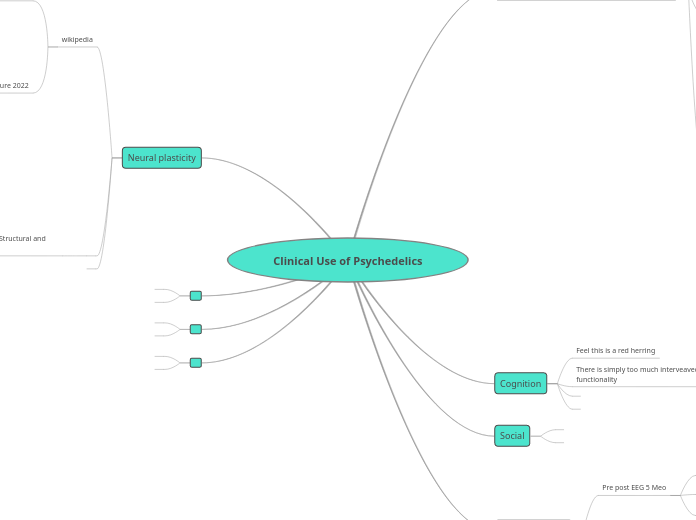Clinical Use of Psychedelics
What is the primary purpose of the brain
Balance the three F's
Navigate current environment?
Navigate social relationships
Brain can navigate multiple disparate problems -- but the heart of all problems it navigates is social relations (Robin Dunbar Evolutionary psychologist at University of Oxford)
Where to integrate Hoffmans work on evolution of the fit
Human Intelligence is Social Intelligence
Therefore, makes sense to examine the effects of psychedelics on social intelligence rather than focusing on the effects psychedelic's on cognition.
Behaviors that can be described as prosocial include feeling empathy and concern for others.
Me
us
we
we argue that empathy is an ability common to humans and many other animals, which has evolved primarily to support a range of prosocial behaviours, from parental care to helping
Delics and empathy
feeling for what others feel?
leads to emotional contagion
not so sure delics do that
Delics lead to a pre-empthay state
the recognion, acceptance and non threatening awareness of more than me?
Empathy does not require complex cognitive capacities such as theory of mind (ToM), or a conscious awareness of one’s feelings and others’ feelings, but it does entail a basic ability to discriminate between self-generated versus externally-caused stimulation.
Detecting distress in others?
Early automatic component N200 which relfects empathic arousal
Overall, clinical and social neuroscience research lends strong support to the notion that emotion reactivity in general, particularly the sharing of another’s distress, plays a pivotal role in facilitating prosocial behaviour.
Cognition
Feel this is a red herring
There is simply too much interveaved cortical functionality
Social
Actual Research
Pre post EEG 5 Meo
How it was done
Choices Analytical
Results
Right Angular Gyrus
Pre Post MD LSD
Analysis of live 5Meo expeprience
Neural plasticity
wikipedia
An apical dendrite is a dendrite that emerges from the apex of a pyramidal cell.[1] Apical dendrites are one of two primary categories of dendrites, and they distinguish the pyramidal cells from spiny stellate cells in the cortices. Pyramidal cells are found in the prefrontal cortex, the hippocampus, the entorhinal cortex, the olfactory cortex, and other areas.[2] Dendrite arbors formed by apical dendrites are the means by which synaptic inputs into a cell are integrated.[3] The apical dendrites in these regions contribute significantly to memory, learning, and sensory associations by modulating the excitatory and inhibitory signals received by the pyramidal cells.
Mc Clure 2022
Induction of spine formation.
Recently, we discovered and others99,100 confirmed that psychedelics can alter synaptic plasticity by enhancing dendritic spine formation on
cortical neurons in vitro and in vivo by activating 5- HT2A receptors. Furthermore, we have found that many of the biochemical and behaviorl actions of psychdlcis are dependenct on the 5 ht 2a receptor interactioons with synapetic scaffolding protiens that are enriched in dendritic spine. Anti-depressansts can also induce spine formation and synarpic plasticity . This supposrts a mode;l for tx actions of delciss that point to a process that could enhncce synatoic plasticity.
Ly et al 2018 Psychedelics Promote Structural and Functional Neural Plasticity
Atrophy of neurons in the prefrontal cortex (PFC) plays a key role in the pathophysiology of depression and related disorders. The ability to promote both structural and functional plasticity in the PFC has been hypothesized to underlie the fast-acting antidepressant properties of the dissociative anesthetic ketamine. Here, we report that, like ketamine, serotonergic psychedelics are capable of robustly increasing neuritogenesis and/or spinogenesis both in vitro and in vivo
